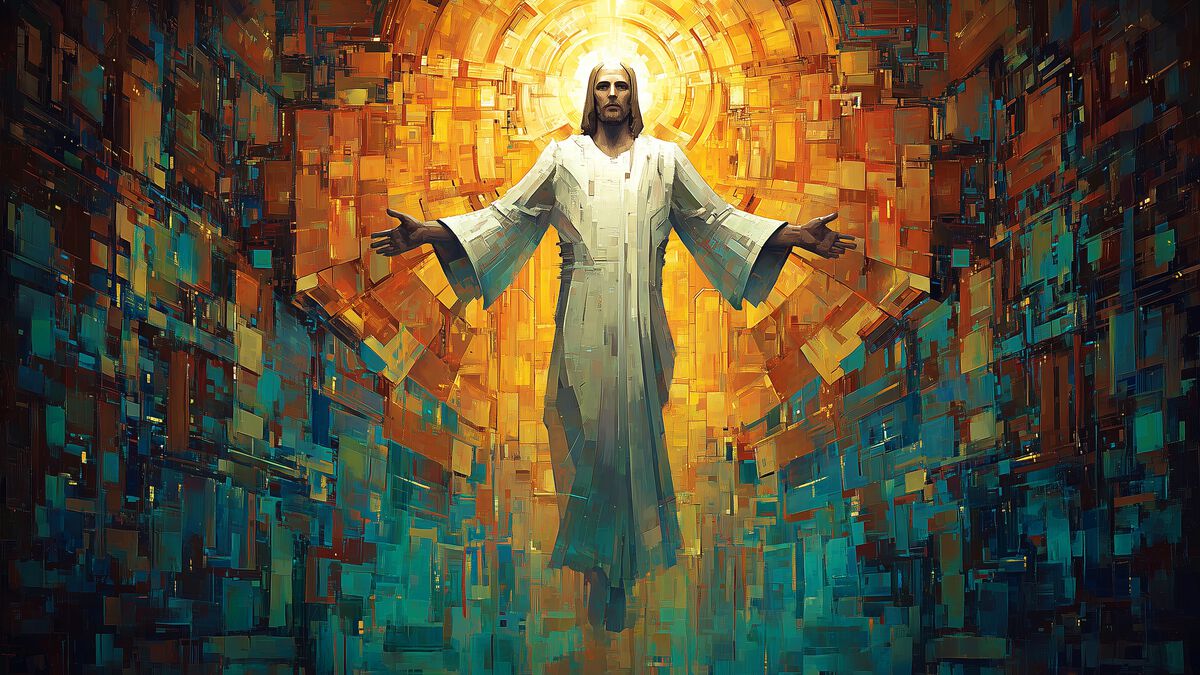Distorting Transhumanism at Meridian Magazine
Lincoln Cannon
7 May 2025 (updated 21 September 2025)
Meridian Magazine positions itself as a publication for members of The Church of Jesus Christ of Latter-day Saints, the largest Mormon denomination. I don’t know much about Meridian or the people behind it. But today I learned that they’re willing to publish a fear-mongering distortion of Transhumanism, “Human 2.0 Is Here – And You Didn’t Even Notice” by Alexis Tarkaleson. Despite their positioning, I wish to make make clear that such behavior is not aligned with the values that the Church advocates.
Tarkaleson says “mind uploading” is an outlandish tale. What’s her take on tales of transfiguration and resurrection? Are those equally outlandish? Surely she’s aware that those doctrines require the possibility of mind (or spirit body) moving from one physical body to another, consistent with hypotheses of mind uploading.
How about cryonics, yet another outlandish tale she identifies? I’m curious to know what she thinks about the Church’s advocacy to collect genealogy and preserve family history, with intent to facilitate redemption of the dead. And what about proxy rituals that we perform for the dead? Most of the world probably thinks the Church’s practices in these areas are at least as outlandish as those of cryonicists.
What about “the god-like ‘posthuman’”? She says that’s outlandish too. Is she aware that Joseph Smith, the founding prophet of the Church, claimed that God “was once a man like us” in his last general conference sermon? If Joseph was right, as I trust, that would literally make God a posthuman.
If these Transhumanist ambitions are merely “crazy sci-fi,” as Tarkaleson suggests, then the doctrines of the Church are crazy religious fiction. You see, the biggest difference between these ambitions isn’t their audacity, which detractors would disparage as mere fiction. Rather, the biggest difference is the narrative esthetic in which these ambitions are commonly expressed. Esthetics do matter, but not so much that we should willfully distort common underlying functions.
Tarkaleson echoes someone else’s professed concern with Transhumanism’s “obsession” with anti-aging and perfectionism. That seems hypocritical coming from a member of a Church, in whose buildings one can hear, just about any Sunday, that human immortality is part of the work and glory of God.
But Tarkaleson has bigger concerns with Transhumanism, she says. She identifies those concerns as “gender ideology,” “reproductive technology,” “abandonment of religion and family,” and “diminishing value of human life and human relationships.” Let’s look at what she says.
Gender Ideology
First, Tarkaleson addresses gender ideology. And she starts by criticizing a strawman of the concept of morphological freedom. She characterizes it as “unlimited freedom to transform your body … on a whim,” while mentioning but not fully taking into account the fact that most Transhumanists actually would limit that freedom to be “so long as it does not harm others.” I wonder if she doesn’t like the doctrine of agency, as advocated by Mormon scripture and the Church? Whether we like it or not, morphological freedom is a kind of agency.
Tarkaleson says that Transhumanists have given morphological freedom “the ultimate position of sacredness by placement in the Transhuman Bill of Rights.” As it turns out, Mormon scripture has done functionally the same thing with the doctrine of agency. Our scriptures even go so far as to claim that Satan “sought to destroy the agency that God had given to His children.” Whose side is she on?
To emphasize her concern with gender ideology, Tarkaleson aims her criticisms at two prominent Transhumanists. One is Martine Rothblatt, who is transgender. And the other is Fereidoun M. Esfandiary (FM2030), who advocated for androgyny and asexuality. Such Transhumanists are, Tarkaleson correctly points out, natural allies with the transgender movement.
Yet some Transhumanists have concerns with how some expressions of the transgender movement have harmed others, going beyond the limits of morphological freedom. Some of us think gender is a blessing rather than a curse, and more likely to extend into than disappear from our posthuman future. And some of us know that secular persons and values are hardly the oldest forerunners of Transhumanism, which can actually trace its history back through deeply religious proto-Transhumanists and beyond to ancient religious analogs of Transhumanism.
Reproductive Technology
Next, Tarkaleson addresses reproductive technology. Here, she starts with asserting that Transhumanism finds its roots in birth control and abortion. This claim is absurd to the point of being stunning. The best evidence she can muster is a quote from a non-Transhumanist advocate of artificial reproduction.
Tarkaleson says that Transhumanists cry out, “More, more, more,” as society speeds ahead with unethical reproductive technology. Again, she has no evidence for this claim regarding Transhumanists in particular. But she does again try to support this characterization of Transhumanists by citing stats about non-Transhumanists. I wish I didn’t need to say that her reasoning is vague and poor.
As it turns out, Transhumanists probably do generally support ethical approaches to the use of reproductive technology. And they’re far from alone. Another organization that supports ethical use of reproductive technology is the Church. Here’s the official Church policy on children conceived by artificial insemination or IVF:
“Children conceived by artificial insemination or in vitro fertilization are born in the covenant if their parents are already sealed. If the children are born before their parents are sealed, they may be sealed to their parents after their parents are sealed to each other.”
Tarkaleson criticizes IVF in particular, along with other reproductive technologies. She claims, “future generations will be detached from all the benefits that come from a natural conception and birth.” I wonder what she thinks of countless members of the Church who wouldn’t be alive, or whose posterity wouldn’t be alive, if they had not benefitted from reproductive technology. Whatever she thinks, many of the rest of us think these technologies can be blessings from God.
This leads her to eugenics, with which she charges Transhumanists. She does allude to the fact that most Transhumanists actually oppose eugenics because it entails coercion. But then she blithely dismisses this problem with her charge. Apparently Tarkaleson thinks people shouldn’t be permitted to do things she doesn’t like, even if those things don’t hurt anyone.
Tarkaleson has concerns with anyone “destroying embryos that don’t check the box.” I know Transhumanists who have intentionally proceeded to give birth to children with known genetic abnormalities such as Down Syndrome. But beyond that discrepancy with her indignation, is she suggesting that we shouldn’t even attempt to know or take responsibility for the well-being of our as-yet-unborn children? Isn’t that intention toward ignorance and impotence just as malicious as careless destruction of embryos?
She is particularly alarmed by reproductive technologies that would permit single persons or groups of persons to procreate. While I would likely agree with her evaluation of the general benefits of traditional families, I wonder if she has thought much about the nature of spiritual procreation entailed by Mormon theology. And how does Mormonism’s history with divinely-sanctioned polygamy fit into her view of these matters? This matter is more complex than she has acknowledged, even if it’s rightly recognized as an area with significant risk.
Beyond her general hand-waving about reproductive technology, Tarkaleson completes her criticism of Transhumanism, finally, by returning to an actual Transhumanist, Zoltan Istvan. He apparently predicted that traditional childbirth will be eradicated within 50 years. She thinks his claim is sufficient to conclude that Transhumanists think there’s nothing to be gained from tradition or Mother Nature. Unfortunately for her, or fortunately depending on your perspective, some of us actually think there’s much to learn from tradition and Mother Nature, even while continuing to create using all the means that the grace of God provides.
Peacemakers
That’s it. Tarkaleson doesn’t explain her concerns with Transhumanism’s supposed conflicts with religion, family, relationships, and humanism. Would she be surprised to learn that Mormon Transhumanists love our religion, families, relationships, and humanity? She threatens to write about those things in part two of an article series that Meridian Magazine should never have started publishing in the first place.
I mentioned in my intro that Meridian’s choice to publish this article does not align with the values of The Church of Jesus Christ of Latter-day Saints. And I’ve suggested some reasons for that, ways in which Transhumanism aligns with Mormon values, throughout the body of this article. But there’s a bigger reason, particularly bigger for Meridian and its audience.
Current president of the Church, Russell M. Nelson, has encouraged members of the Church to be peacemakers. “Replace belligerence with beseeching, animosity with understanding, and contention with peace,” he urged in a recent general conference. And, he continued, “make any adjustments that may be needed so that your behavior is ennobling, respectful, and representative of a true follower of Jesus Christ.”
By choosing to publish a fear-mongering distortion of Transhumanism, Meridian has engaged in exactly the opposite of the behavior that President Nelson encouraged. As a consequence, many of its readers will misunderstand and fear Transhumanism, like many people misunderstand and fear members of the Church. And some who misunderstand and fear the Church will misunderstand and fear it even more as a consequence of their article, thinking it representative of the Church. It’s a vicious cycle.
To those reading this who may not know much about Transhumanism, about Mormonism in general, or about The Church of Jesus Christ of Latter-day saints in particular, please know that there are far better sources than Meridian Magazine for information on the relationship between Mormonism and Transhumanism. Some members of the Church actually identify as Transhumanists. And some of us organized the Mormon Transhumanist Association two decades ago. That would be a good place to start, where you can read charitable accounts of both Transhumanism and Mormonism, and the Church, from people who understand them well enough to make peace.



